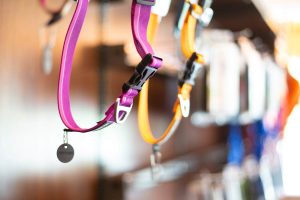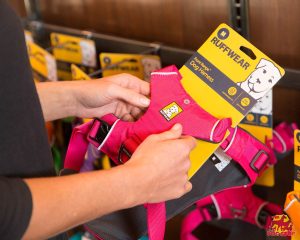Is a harness or collar better for dog walking?

While dog collars are still commonly used for dog walking, harnesses are becoming more popular. One is not necessarily better than the other, but each has its advantages and disadvantages in certain situations.
In general, the effectiveness of them depends on the type of dog you have. Let’s look more at the pros and cons of harnesses and collars for dog walking.
Dog Collars
Pros 
The most important aspects to consider when choosing what’s best to use for dog walking, are the comfort and safety of your canine. A traditional collar is a good option if you have a well-behaved pooch that isn’t always jumping, pulling, and zig-zagging around. Collars are also more comfortable for this type of dog, especially if you’re planning to go outside for longer periods of time.
If you have a dog with a slim neck, it’s recommended to get the slip collar, which is specifically designed for doggies that are prone to slipping out. A collar is also a good and secure way to store ID tags, which is crucial to have in case your pooch runs away.
Cons
 Now, if your furry friend is a wild one and likes to pull hard when walking outside, a collar isn’t the best option. This is because too much pulling can cause neck injury and can even choke them. According to Dr. Peter Dobias, there is a high rate of thyroid disease among dogs who pull strongly when on the leash.
Now, if your furry friend is a wild one and likes to pull hard when walking outside, a collar isn’t the best option. This is because too much pulling can cause neck injury and can even choke them. According to Dr. Peter Dobias, there is a high rate of thyroid disease among dogs who pull strongly when on the leash.
If you can’t control your pup when walking outside, a harness is a better option.
While a collar is effective when training your pup, it’s crucial that you pick out the right collars for your furry friend. Avoid getting the choke and prong collars that are designed to cause discomfort when your dog tries to pull hard. While this type of collar is created for training purposes, it can seriously injure your dog.
Collars are also not suitable for a tiny doggie, because it can be hard to fit correctly and your pooch can easily slip out.
Dog Harness
Pros

For strong-pulling dogs, a harness is the best option. Harnesses allow you to have more control over your pooch, and it won’t put pressure on the neck if they start to pull. The harness is strapped on the chest and shoulders, which reduces the strain on the neck and the back. It’s also one effective way to discourage pulling, as it becomes a lot harder to do so and will wear them out faster.
Harnesses are also suitable if you have an extra small or large canine. There are many different options as harnesses come in all shapes and sizes.
Since harnesses are less constraining on the neck, it’s a more suitable option if your pup has a medical condition in the neck or airways.
Cons
The harness requires a bit more due diligence to reduce the risk of injury. Chaffed skin around the elbow is common if the harness isn’t properly attached. Chaffed skin can lead to further skin irritations if left untreated, so be sure to check if the harness is rubbing on their skin. If your doggie has long hair you also have to be careful that their hair doesn’t get caught in the buckles as this can also cause discomfort.
So when it comes to deciding if you use a harness or collar, you really need to assess the size and excitability of your dog when walking. Still unsure of which type would best suit your dog? Visit one of The Dog Stop’s many retail stores. Our staff members are well-equipped with the knowledge and experience to give you advice.
